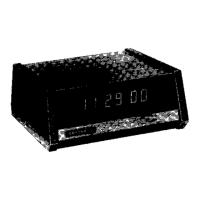Page 26
CIRCUIT FUNDAMENTALS
The following fundamentals will give you a better
understanding of the circuit relationships in your Clock and
describe how the circuits work together. Refer to the
Schematic Diagram (fold-out from Page 31) while you read
the following information.
All the digital logic is performed inside of IC201. The
remaining circuitry supplies the DC power and responds to
the commands from IC201 to drive the speaker and the
display tubes.
Resistor R204 and capacitor C201 are the timing
components for the oscillator inside IC201. The oscillator
scans (applies a positive driving pulse to first D1, then D2,
then D3, etc.) outputs D1 through D6 in rapid succession.
At the correct times, positive pulses are applied to the
proper pins (9 through 15) of IC201 to turn on the correct
digits in the proper display tubes.
Example: Consider the time 08:56:21.
As a positive pulse is applied to D1 (which turns on
transistors Q201 and Q202, and applies 230 volts to the
anode of tube V103, part A), positive pulses are also applied
to pins 13 and 14 of the IC. These pulses at pins 13 and 14
turn oh transistors Q105 and Q107, which turn on segments
b and c of the display tube, and a one is displayed. The
other digits (of V103, V102, and V101) do not light up
because they do not have a high enough voltage at their
anodes.
The positive pulse is then applied to D2, and part B of tube
V103 receives the high anode voltage. At this same time,
positive pulses are also applied to pins 9, 11, 12, 14, and 15
of the
IC.
This turns on segments a, b, g, e, and d, and a two
is displayed.
Next, positive pulses are applied to D3 and pins 9, 10, 11,
12, 13, and 15 of the IC, and a six is displayed in part A of
V102. The scanning continues through D6 and then starts
over. This happens so fast that all six digits appear to be on
at once.
Transistor Q213 turns on lamp V201 at the proper time
when the alarm or time is being set, and transistor Q214
drives the speaker, SP301.
Diodes D204 through D211 are a diode matrix to keep the
DC voltages on their own control lines.
(D1
through D6 are
the control lines.)
Dual-primary transformer T301 can be wired to operate
from either 120 VAC or 240 VAC. Two secondary windings
furnish the voltage required by the Clock. Diode D201
forms a half-wave rectifier, and capacitor C203 and resistor
R211 filter this voltage that drives the display tubes. Diode
D202, resistor R210, and capacitor C204 also are a rectifier
and filter circuit, and zener diode ZD201 maintains the
proper operating voltage for IC201. Diode D203 is another
rectifier and, along with resistors R209 and R208, provides
the proper 50 or 60 Hz signal to act as the Clock's reference
frequency. Capacitor C202 is a filter capacitor.

